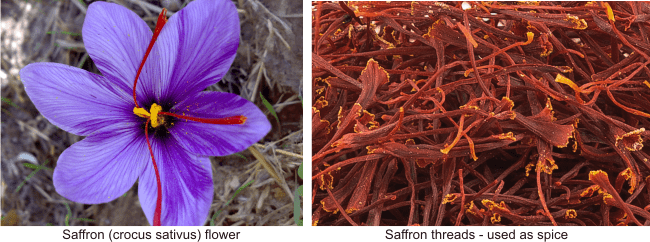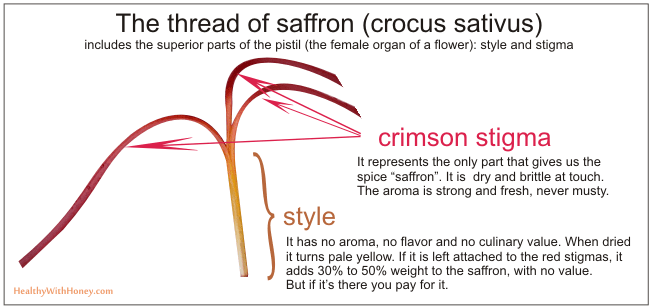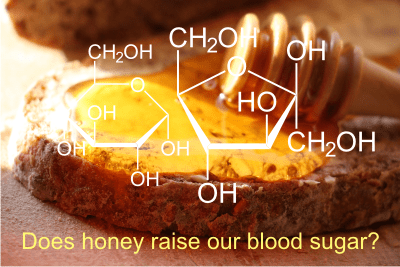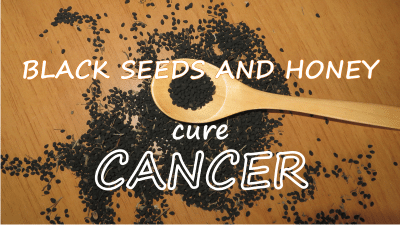Known mostly for its aphrodisiac properties, saffron honey is indeed a honey good for sex life but not only! It’s a rare type of honey one can find more in Iran, Morocco, Greece, India or Spain. Its infused alternative is nevertheless worldwide available and very easy to make at home. All you need is good quality saffron and raw honey, preferably also with aphrodisiac qualities, like acacia, sunflower and honeydew honeys.
As for a real saffron honey, made from the nectar of the flower, I couldn’t find any, though I’m sure it exists somewhere, in an Arab online shop. And that’s because the flower represents a useful source of both nectar and pollen and attracts many insects. Bumblebees and butterflies are regular visitors but so are the honey bees, when their hives are placed near saffron crops. Here is the evidence:
But because nobody has the patience and money to search for a real saffron honey, the infused one is more often find in people’s homes (in Greece there’s even a tradition to make it). It’s available in health shops and online, even on Amazon.
What’s so special about saffron?
It’s a spice, as you know, the most expensive spice in the world, around 30,000 €/kg. That’s because it is made of the threads of the flower, which weigh very little.
The saffron
Scientific name: crocus sativus
Other names: saffron, saffron crocus, or autumn crocus. or the red gold!
Etymology:
The name comes from the Hebrew “sahafaran” meaning thread. The Arabic word “zafaran” means yellow. Other 2 Greek words “croci” and “karkom” (meaning yellowish) are considered to be at the rood of the word saffron, aka crocus sativus.
Species:
The genus Crocus is composed of 85 species, many of them being grown as house plants, in ornamental and gardens, rock gardens and parks. Some of them bloom in spring: C. biflorous, C. aureus, C almehensis, but most of them bloom in fall: C. sativus, C. caspicus, C. gilanicus, C. longiflorus and so on. There are even species that flower in winter: C. michelsonii and C. korlkowii.
The saffron crocus (Crocus sativus) should not be confused with “meadow” saffron or autumn crocus (Colchicum autumnale) which is poisonous.
Distribution:
It is cultivated mostly in Iran, Spain and India. Saffron is also endemic to Greece and other Mediterranean regions and it cultivated in a limited amount in countries like the US, Turkey, Italy, Pakistan, France. Iran’s saffron production comprises more than 95% of the entire world production, with 150/170 Mt., then there are the other small producers: Greece (5/7 Mt.), Morocco (2/3 Mt), Kashmir (2/3), Spain (1Mt. or less), Italy (only100 kilos or less).
Characteristics:
Saffron is a perennial plant that flowers in mid-autumn. This happens at dawn and then the flowers quickly wilt as the day passes. All plants bloom within a window of one or two weeks. The flowers are gathered but only the stigmas will be then collected and quickly dried and sealed in airtight containers.
The flowers are hermaphrodite (have both male and female organs) and are pollinated by bees and butterflies. The plant prefers light and medium soils, requires well-drained soil, and can grow in nutritionally poor soil. The flower has three stigmas,

The flowers have a sweet, honey-like flagrance. The petals are vivid purple, the stigma (the female organ) is crimson, the stamens (the male organs that hold pollen andhave no use in cooking) are yellow and the nectar found within is yellow, too. Upon flowering, the plants are 20–30 cm (8–12 in) in height and bear up to four flowers. The threads, which include the vivid crimson stigmas and style, are collected and dried to be used mainly as a seasoning and as a coloring agent in food.

Because only the stigmas are used to produce this spice, the price is very high. To make 1 kg of dried saffron (which will contain at least 200,000 stigmas), 40 hours of labor are needed, for gathering around 150,000 flowers.
1 freshly picked flower → 30 mg (0.0011 oz) fresh saffron
or 7 mg (0.00025 oz) dried saffron
150 flowers → 1 g (0.035 oz) of dry saffron threads;
1 kg (2.2 lb) of flowers →12 g (0.42 oz) of dried saffron
50,000–75,000 flowers → 1 lb (450 g) of dry saffron
110,000–170,000 flowers →1 kg dry saffron
Composition of saffron
Saffron’s aroma is reminiscent of metallic honey with grassy or hay-like notes. The taste has is hay-like and sweet. Dried saffron is composed of 65% carbohydrates, 6% fat, 11% protein (table) and 12% water.
Saffron contains more than 150 volatile and aroma-yielding compounds, mainly terpenes, terpene alcohol, and their esters. The characteristic components of saffron are:
· crocin -(responsible for the color),
· picrocrocin– (responsible for the bitter taste),
· safranal– (responsible for aroma and an iodoform or hay-like fragrance).
Among the other components, the most important may be considered:
– An antioxidant 3,8-dihydroxy-1-methylanthroquinone-2-carboxylic, claimed to be superior to vitamin E in its inhibition of oxidation of linoleic acid, isolated from callus stem tissue of saffron.
– Flavonoids, such as rutin, quercetin, luteolin, hesperidin, and bioflavonoids.
– Volatile and non-volatile components.
– Vitamins (rich in Vitamin B) and dietary minerals. In a serving of one tablespoon (2 grams), manganese is present as 28% of the Daily Value.
The volatiles compounds with a very strong odor are consistent of more than 34 components that are mainly terpenes, terpene alcohols, and their esters.
Nonvolatiles compounds include crocins 14 that are responsible for the red or reddish brown color of stigmas together with carotenes (including zeaxanthin, lycopene, and various α- and β-carotenes), crocetin, picrocrocin (a glycosidic precursor of safranal), and safranal. Saffron’s golden yellow-orange color is primarily due to α-crocin.
Culinary use of saffron:
Added to foods or beverages, it brings a luminous yellow-orange color. It is widely used in Persian, Indian, European, and Arab cuisines.
Confectioneries and liquors also often include saffron. Many dishes are made with saffron, you surely know of:
– jewelled rice and khoresh of Iran,
– Milanese risotto of Italy,
– paella of Spain,
– bouillabaisse of France,
– biryani with various meat accompaniments in South Asia.
– Golden Ham, a precious dry-cured ham made with saffron from San Gimignano.
Very important tip: when we use saffron in our dishes we should soak it first in hot water (but not boiling) for 20 minutes to release the aromatic components. Do not remove the saffron threads from the liquid. Use it like this. The threads to release aroma, flavor and color for up to 24 hours. It is said that this is reason why dishes with saffron always taste even stronger.
Medicinal use of saffron:
from older times:
· there is clear documentation of saffron’s use for over 4000 years in the treatment of some 90 illnesses.
· Hippocrates recommended it for indigestion and tooth ache.
· Saffron is mentioned in the Chinese materia medica from the 1550s.
· It is used for depression in Persian traditional medicine.
· In the East, it is said to bring wisdom and cheerfulness, being also used in association with opium, to treat hysteria
· In traditional Indian medicine it is used as analgesics and cardio-protective agents, as well as in the treatment of various kinds of mental illnesses. Further reading: ayushveda.com
· Good for blood circulation, relieves menstrual pains and acts as an aphrodisiac for women.
from today:
· Saffron is used as antihypertensive, anticonvulsant, antitussive, antigenotoxic and cytotoxic effects, anxiolytic aphrodisiac, antioxidant, antidepressant, antinociceptive and anti-inflammatory. It improves memory and learning skills and increases blood flow in retina and choroid.
· Safranal, the component that gives the bitter taste, when taken in large quantities is a very effective natural suppressant for appetite. You will eat less and thus lose weight. (You can find it in tablet form on Amazon)
· In homeopathy it is used for women blood circulation troubles.
Antihypertensive activity:
Aqueous and ethanol extracts of C. sativus petals reduced the blood pressure in a dose-dependent manner. (Fatehi et al., 2003)

Anticonvulsant activity:
Safranal, a main constituents of saffron, reduced seizure duration, delayed the onset of tonic convulsions, and protected mice from death in a study conducted by Hosseinzadeh H et al. in 2005.
Antitussive activity:
In was showed that the ethanolic extract of Crocus sativus (100-800 mg/kg) and safranal (0.25-0.75 ml/kg) reduced the number of cough. The study was done by Hosseinzadeh H et al. in 2006. Not all extracts had the same effect: the ethanolic and aqueous extracts of petal and crocin did not show antitussive activity.
Antigenototoxic and cytotoxic effects of saffron
The antimutagenic, comutagenic, and cytotoxic effects were tested in the study conducted by Abdullaev FI et al. in 2003. It demonstrated that saffron itself, as well as its carotenoid components might be used as potential cancer chemopreventive agents.
Aphrodisiac effects:
The aphrodisiac activities of saffron stigma aqueous extract and its constituents, safranal and crocin, were evaluated in male rats in a study conducted by Hosseinzadeh H et al. in 2008.
The researchers measured the mounting frequency, intromission frequency, erection frequency, mount latency, intromission latency and ejaculation latency. Crocin, at all doses, and the extract, especially at doses 160 and 320mg/kg body wt., improved all sexual activity, with theexception of safranal, which did not show aphrodisiac effects. The present study reveals an aphrodisiac activity of saffron aqueous extract and its constituent crocin.
Anxiolytic activity
The test conducted by Pitsikas N et al. in 2008 demonstrated the anxiolytic properties of crocins in saffron. . Either crocins, at a dose which did not influence animals’ motor activity (50 mg/kg), or diazepam (1.5 mg/kg), increased the latency to enter the dark compartment and prolonged the time spent in the lit chamber in the rats.
Relaxant property
The study done on guinea pigs by Nemati H et al. in 2008, indicated a relatively potent stimulatory effect of the extract from Crocus sativus on beta(2)-adrenoceptors which is partially due to its constituent, safranal. A possible inhibitory effect of the plant on histamine (H(1)) receptors was also suggested.
Antidepression effect
In a 6-week double-blind, placebo-controlled and randomized trial 40 adult patients with mental disorders were randomly assigned to receive capsule of petal of C. sativus30 mg/day (b.d.) and capsule of placebo. At 6 weeks, petal (not regular saffron made from stgma) of C. sativus produced a significantly better outcome on Hamilton Depression Rating Scale than placebo.

The results of this study indicate the efficacy of petal of C. sativus in the treatment of mild-to-moderate depression. It was found that the saffron petals performed as well as the drug fluoxetine in the treatment of depression. It was thus demonstrated that petals of crocus sativus, the part of this herb that is very cheap compared to stigma, has antidepressant effect(Karimi G et al, 2001).
Effect on learning behavior and long-term potentiation
The saffron extract and two of its main ingredients, crocin and crocetin, improved memory and learning skills in ethanol-induced learning behavior impairments in mice and rats. Oral administration of saffron may be useful in the treatment of neurodegenerative disorders and related memory impairment. ( Sigiura M et al. 2005)
Effects on ocular blood flow and retinal function
Crocin analogs isolated from saffron significantly increased the blood flow in the retina and choroid as well as facilitated retinal function recovery and it could be used to treat ischemic retinopathy and/or age-related macular degeneration (Xuan B et al, 1999)
Effect on coronary artery disease
Fifty milligrams of saffron dissolved in 100 ml of milk was administered twice a day to human subjects, and the significant decrease in lipoprotein oxidation susceptibility in patients with coronary artery disease (CAD) indicates the potential of saffron as an antioxidant (Verma SK et al. in 1998)
Antinociceptive and anti-inflammatory effects
Saffron stigma and petal extracts exhibited antinociceptive effects in chemically induced pain test as well as acute and/or chronic anti-inflammatory activity, and these effects might be due to the presence of flavonoids, tannins, anthocyanins, alkaloids, and saponins (Hosseinzadeh H et al. 2002).
Anticancer properties
The study “The toxicity of saffron (Crocus sativus L.) and its constituents against normal and cancer cells“, by AlirezaMilajerdi et al. published in 2015, showed that saffron has a selective toxicity against cancer cells with crocin as the most important anticancer component of it. Theresearch team also showed that crocetin inhibits the growth of cancer cells and saffron’s toxicity against normal cells is very low at common doses.
The atitumor activity of saffron was also proved in the study made on mice, Antitumour activity of saffron by S.C.Nair et al. from India and published in 1991.
Taking saffron tablets changes blood parameters.
Clinical examination showed no gross changes in all volunteers after 1-week treatment with 200 and 400 mg saffron tablets. The 400 mg saffron decreased standing systolic blood pressure and mean arterial pressures significantly. Saffron decreased slightly some hematological parameters such as red blood cells, hemoglobin, hematocrit, and platelets. Saffron increased sodium, blood urea nitrogen, and creatinine.
However the changes were in normal ranges and they were not important clinically (as shown in the study conducted by Modaghegh MH et al in 2008)
WebMD says saffron is possibly safe for most people when taken by mouth as a medicine for up to 6 weeks. Some possible side effects include dry mouth, anxiety, dizziness, drowsiness, nausea, change in appetite, and headache. Allergic reactions can occur in some people. High doses can cause poisoning, including yellow appearance of the skin, eyes, and mucous membranes; vomiting; dizziness; bloody diarrhea; bleeding from the nose, lips, and eyelids; numbness; and other serious side effects. Doses of 12-20 grams can cause death. It think it’s good to know!
Beware of fake saffron!
Its high price is too blame for the temptation of faking it, nothing new here.
Fake saffron may be grouped in three categories; substitution of other materials that have some external resemblance to saffron; exhausted saffron recovered by dyes; and substances added to saffron in order to increase its weight.
Materials used as substitutes may be mixed with saffron or supplied in place of saffron, the following have been used: styles of crocus, which are yellowish, slender, and unbranched; stamens and strips of the corolla of saffron crocus; ligulate carollas of florets of the marigold, Calendula officinalis, which are often colored with methyl orange and sometimes known as feminell or Chinese safflower; ligulate florets of safflower, Carthmus tinctorious. Linn often found in the cake saffron of commerce; slender stems and roots of some monocotyledons (e.g., Carex), colored artificially and stigmas of Zea mays Linn, known as corn silk. (Wallis TE. 2005)
What is saffron honey?
It is said that honey and saffron are like a match made in heaven. Both are powerful health enhancing natural products that and together they offer a unique blend of health-giving nutrients and taste.
1 teaspoon contains 3 mg of saffron.
As it is really hard to find real saffron honey made by honey bees, people use regular raw honey and infuse it with saffron stigmas. Here is how it’s done:
1/2 cup mild honey (anything, from acacia, sunflower to clover or tupelo)
1/2 teaspoon saffron threads
Stir them in a glass jar with screw top. Close the jar and let it stay for at least 5 days before consumption.
Where can I find saffron honey?
• Here is an Indian shop which says it sells real nectar saffron honey herbalglobal.com. But there are not many details and no reviews anywhere.
• On Amazon, selling infused saffron honey made in USA from raw grade A honey and Spanish saffron : Exir Honey Plus Saffron Organic 2 x 8-oz (1 LB) | with Host of benefits; Helps you from head to toe, or from Greece.
Enjoy the homemade honey saffron on a slice of buttered whole-grain bread for breakfast or drizzled over a bowl of Greek yogurt with a few toasted walnuts. It’s amazing! Or spoon some into a bowl of warm breakfast oats and wait for the vibrant strands to release their orange hues.
Beyond its obvious health value, saffron honey is really tasty. You can enjoy it on a slice of buttered bread or drizzled over a bowl of greek yogurt with some walnuts, or a bowl of breakfast cereals. yummy…
References and picture source:
https://www.ncbi.nlm.nih.gov/pmc/articles/PMC3249922/
foodreference.com/html/artsaffron.html
https://en.wikipedia.org/wiki/Saffron
https://en.wikipedia.org/wiki/Crocus_sativus
britannica.com/story/why-is-saffron-so-expensive
Saffron flower picture by Serpico – Own work, CC BY-SA 3.0, https://commons.wikimedia.org/w/index.php?curid=11822266
Saffron threads picture by Hubertl – Own work, CC BY-SA 4.0, https://commons.wikimedia.org/w/index.php?curid=38618139




